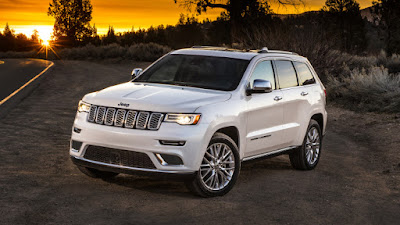Vehicle Summary
The five-passenger Grand Cherokee sits at the top of Jeep’s lineup as its largest, most expensive, and—in certain trim levels—most luxurious SUV.
Overview
The Grand Cherokee was an instant hit when it was introduced for the 1993 model year, and subsequent versions—there have been four major revisions in total—always seemed to strike just the right note with buyers. To this day, the Grand Cherokee rides high on the Jeep brand cachet that it helped to create. With five models on offer for 2017—Laredo, Limited, Overland, Summit, SRT, and the new-for-2017 Trailhawk—the Grand Cherokee seems to be willing to play any role it is offered: Sensible all-weather family wagon, luxo-yacht, bare-knuckle street racer, or hard-core off-roader.
The Grand Cherokee offers four engines, all tied to an eight-speed automatic transmission. Chrysler’s 295-hp, 260-lb-ft 3.6-liter “Pentastar” V-6 is standard in all models save for the SRT, and in all but the entry-level Laredo it can be replaced by either a 360-hp, 390-lb-ft 5.7-liter V-8 or a 240-hp, 420-lb-ft 3.0-liter turbodiesel V-6. EPA fuel economy estimates with the gas V-6 are 19/26 mpg city/highway with rear-wheel drive and 18/25 mpg with four-wheel drive; the V-8 drops that to 14/22 mpg with 4WD (RWD numbers were not announced at time of writing), while the diesel increases those numbers to 22/30 mpg with RWD and 21/28 mpg with AWD. The SRT does its own thing with a 6.4-liter V-8 that produces 475 hp and 470 lb-ft, comes exclusively with four-wheel drive, and is EPA rated at 13/19 mpg. Coming soon 2020 Jeep Grand Cherokee Release Date Configurations
Safety
The Jeep Grand Cherokee gets a perfect five-star rating from NHTSA when equipped with four-wheel drive, but rear-drive models get only four stars. Front and side crash ratings are five stars for both, but the RWD version gets three stars for rollover versus the 4WD’s four. The Insurance Institute for Highway Safety hasn’t tested a 2017 Grand Cherokee, but gave the 2016 model its best rating (“Good”) for all tests except its difficult new small-overlap crash test, in which the Grand Cherokee was rated “Marginal”—that’s only one step up from the bottom. Available active safety features include forward collision warning and mitigation with automatic braking, adaptive cruise control, and lane-departure and blind-spot warning systems.
What We Think
The fact that we put a Grand Cherokee up against a Mercedes-Benz ML, a Porsche Cayenne, and a Volkswagen Touareg should give you some idea of the regard we have for Jeep’s flagship SUV. Granted, having a diesel engine was the price of entry to this comparison, but the Grand Cherokee fit nicely into this company. We loved the upscale interior and the intuitive interface, and we were impressed, though not surprised, by its off-road ability. (This was before we had a chance to try the new-for-2017 Trailhawk model, which has even more ground clearance courtesy of a specially developed version of Jeep’s Quadra-Lift air suspension.) At the end of the day, the scores told the story: The Jeep Grand Cherokee won the comparison. “Capability, character, class, and content,” we said. “The hallmarks of a winner.”
The SRT stands outside the rest of the Grand Cherokee family; its idea of “off pavement” is a race track. We put one through its paces on the Circuit of the Americas, and found that Jeep had done a great job tuning this two-and-a-half-ton behemoth to a most un-SUV-like environment. “Its all-wheel-drive system and electronic rear differential put all 465 lb-ft of torque to the ground better than any other SRT vehicle save the Viper,” our tester noted. “Just feed in the gas and it digs at both ends.”
Cool Fact
The original Grand Cherokee program was started when Jeep was still owned by American Motors.
Key Competitors:
Ford Explorer
Toyota 4Runner
Land Rover LR4
Volkswagen Touareg
sources : motortrend










